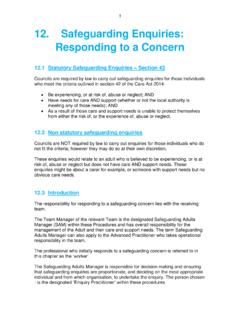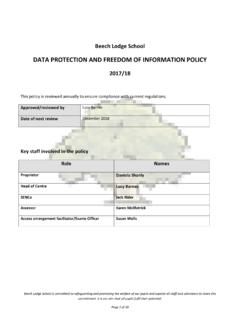Transcription of Working Together to Safeguard Children
1 Working Together to Safeguard Children A guide to inter-agency Working to Safeguard and promote the welfare of Children Working Together to Safeguard Children A guide to inter-agency Working to Safeguard and promote the welfare You can download this publication at of Children publications&ProductId=DCSF-00305-2010. Search using ref: DCSF-00305-2010. Copies of this publication can be obtained from: DCSF Publications PO Box 5050. Sherwood Park Annesley Nottingham NG15 0DJ. Tel: 0845 60 222 60. Fax: 0845 60 333 60. Textphone: 0845 60 555 60. Please quote the ref: 00305-2010 DOM-EN. ISBN: 978-1-84775-715-9. D16(8643)/0310. Crown copyright 2010. The text in this document (excluding the Royal Arms and other departmental or agency logos) may be reproduced free of charge in any format or medium providing it is reproduced accurately and not used in a misleading context. The material must be acknowledged as Crown copyright and the title of the document specified.
2 Where we have identified any third party copyright material you will need to obtain permission from the copyright holders concerned. For any other use of this material please contact the Office of Public Sector Information, Information Policy Team, Kew, Richmond, Surrey TW9 4DU or e-mail: March 2010. 8643-DCSF- Working Together to 1 01/04/2010 09:53. Working Together to Safeguard Children A guide to inter-agency Working to Safeguard and promote the welfare of Children March 2010. A guide to inter-agency Working to Safeguard and promote the welfare of Children 1. Contents Working Together to Safeguard Children : Executive Summary 7. Introduction 7. Part 1: Statutory guidance 8. Part 2: Non-statutory practice guidance 18. Preface 22. Introduction 22. Purpose of the document and who should read it 22. Content of this guidance 24. Other related guidance 24. Status of the document as statutory guidance 25. When does the guidance apply? 26.
3 Glossary 27. Part 1: Statutory Guidance 28. Chapter 1 Introduction: Working Together to Safeguard and promote the welfare of Children and families 29. Supporting Children and families 29. Parenting, family life and services 29. Lord Laming's progress report 30. The Government's response 30. An integrated approach 31. A shared responsibility 31. The child in focus 32. Key definitions 34. Chapter 2 Roles and responsibilities 40. Introduction 40. The statutory framework within which organisations operate 40. Infrastructure and governance to deliver safeguarding responsibilities 42. Information sharing 43. ContactPoint 44. Common Assessment Framework (CAF) 44. Local authorities that are Children 's services authorities 45. Other local authority roles 48. Health services 51. 2 Working Together to Safeguard Children Health organisations 52. Roles of different health services 60. Health professionals 67. Criminal justice organisations 70. Schools and further education institutions 78.
4 Early years services 80. Children and Family Court Advisory and Support Service (Cafcass) 81. The armed services 82. The voluntary and private sectors 84. Faith communities 86. Chapter 3 Local Safeguarding Children Boards 88. LSCB role 88. Scope of the LSCB 89. LSCB functions 90. Other policies and procedures 93. LSCB governance and operational arrangements 99. Membership of an LSCB 102. Chapter 4 Training, development and supervision for inter-agency Working 113. Introduction and definitions 113. Purpose 114. Roles and responsibilities 114. Content, audiences and values 118. Planning, organisation, delivery and evaluation 121. Effective support and supervision 123. Table 1: Suggested training for different target groups 126. Chapter 5 Managing individual cases where there are concerns about a child's safety and welfare 133. Introduction 133. Working with Children when there are concerns about their safety and welfare 133. Principles underpinning work to Safeguard and promote the welfare of Children 134.
5 The processes for safeguarding and promoting the welfare of Children 137. The welfare of unborn Children 140. Referrals to local authority Children 's social care where there are concerns about a child's safety or welfare 140. Response of local authority Children 's social care to a referral 144. Initial assessment 146. A guide to inter-agency Working to Safeguard and promote the welfare of Children 3. Next steps child in need but no suspected actual or likely significant harm 150. Next steps suspicion that a child is suffering, or is likely to suffer, significant harm 151. Immediate protection 152. Strategy discussion 153. Section 47 enquiries and core assessment 155. Child Assessment Orders 158. The impact of section 47 enquiries on the family and child 159. The outcome of section 47 enquiries 159. Concerns are not substantiated 160. Concerns are substantiated, but the child is not judged to be continuing to, or be likely to, suffer significant harm 160.
6 Concerns are substantiated and the child is judged to be continuing to, or be likely to, suffer significant harm 162. The initial child protection conference 162. Action following the initial child protection conference 172. Completion of the core assessment 174. The child protection plan 175. Intervention 176. The child protection review conference 179. Discontinuing the child protection plan 180. Children looked after by the local authority 181. Pre-birth child protection conferences and reviews 182. Recording that a child is the subject of a child protection plan 182. Managing and providing information about a child 183. Recording in individual case records 184. Request for a change of worker 185. Chapter 6 Supplementary guidance on safeguarding and promoting the welfare of Children 191. Introduction 191. Sexually exploited Children 191. Children affected by gang activity 192. Fabricated or induced illness (FII) 192. Investigating complex (organised or multiple) abuse 194.
7 Female genital mutilation 195. Forced marriage and honour-based violence 196. Allegations of abuse made against a person who works with Children 199. Abuse of disabled Children 201. Child abuse linked to belief in spirit possession' 204. Child victims of trafficking 204. 4 Working Together to Safeguard Children Chapter 7 Child death review processes 208. Introduction 208. Overall principles 209. Involvement of parents and family members (for all child deaths) 209. The Regulations relating to child deaths 210. Supply of information about child deaths by registrars 211. Duty and powers of coroners to share information 212. Duty and powers of Medical Examiners (MEs) to share information 212. Definition of an unexpected death of a child 212. Definition of preventable child deaths 213. LSCB responsibilities for the child death review processes 213. Procedures to be followed by the local Child Death Overview Panel (for all child deaths) 215.
8 The process to be followed by Child Death Overview Panels (for all child deaths) 217. Roles and responsibilities when responding rapidly to an unexpected death of a child 220. Other related processes 221. Processes for a rapid response from professionals to all unexpected deaths of Children (0 18 years) 223. Use of child death information to prevent future deaths 231. Chapter 8 Serious case reviews 233. Reviewing and investigative functions of Local Safeguarding Children Boards 233. The purposes of Serious Case Reviews 234. Safeguarding siblings or other Children 234. When should a LSCB undertake a Serious Case Review? 235. When should a LSCB consider undertaking a Serious Case Review? 235. Which LSCB should take lead responsibility? 237. Membership of SCR sub-committees and SCR Panels 237. Instigating a Serious Case Review 238. Timescales for initiating and undertaking a Serious Case Review 241. Who should be involved in the Serious Case Review?
9 242. Individual management reviews general principles 243. The Serious Case Review overview report 247. SCR Panel responsibilities for the overview report 248. The executive summary 249. LSCB action on receiving the Serious Case Review report 251. Reviewing institutional abuse 252. Accountability and disclosure 253. Learning lessons locally 254. Learning lessons nationally 255. A guide to inter-agency Working to Safeguard and promote the welfare of Children 5. Part 2: Non-statutory practice guidance 257. Chapter 9 Lessons from research 258. Introduction 258. The impact of maltreatment on Children 258. Physical abuse 259. Emotional abuse 260. Sexual abuse 260. Neglect 260. Sources of stress for Children and families 261. Social exclusion 262. Domestic violence 262. Mental illness of a parent or carer 265. Parental problem drug use 269. Parental problem alcohol use 274. Parents with a Learning Disability 278. Chapter 10 Implementing the principles on Working with Children and their families 284.
10 Introduction 284. Family group conferences 284. Support, advice and advocacy to Children and families 285. Communication and information 286. Race, ethnicity and culture 286. Children in Families at risk' having very poor outcomes 287. Think Family practice 288. Effectiveness of parenting and family interventions 289. Working with fathers 290. Family Intervention Projects 290. Family Nurse Partnership 291. Chapter 11 Safeguarding and promoting the welfare of Children who may be particularly vulnerable 292. Introduction 292. Children living away from home 292. Abuse by Children and young people 302. Children whose behaviour indicates a lack of parental control 307. Race and racism 308. Violent extremism 309. Domestic violence 310. Child abuse and information communication technology (ICT) 315. Children with families whose whereabouts are unknown 316. 6 Working Together to Safeguard Children Children who go missing 316. Children who go missing from education 317.





